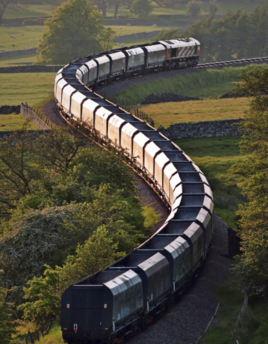Network Rail has “lots under way”, says Chief Environment and Sustainability Officer Jo Lewington.
“The five regions that make up Network Rail each have their own environment teams, so when we renew infrastructure, we do it in a way that is sustainable - and that protects against climate change,” she explains.
“We are looking at catastrophe modelling. We need to build a more resilient railway, knowing where our hotspots are. We are early in this journey.
“We have four pillars of strategy: sustainable land use, decarbonisation, climate change adaptation and what we call the circular economy - minimising waste and use of resources.”
Lewington points to a move from traditional station platform components to low-carbon materials. These reduce embedded carbon by up to 90%.
“We are halfway through Control Period 6. At the beginning of this financial period, the environmental sustainability strategy wasn’t on the radar. This has come along partway through a funding period, and therefore it has been challenging. We know what we need to do, but we are not truly funded to do this.
“Some of it is not about spending more money, it’s about doing things differently with the money we have.”
Quick wins: Rolling stock
Blainey criticises the lack of a coherent national rolling stock strategy, arguing that carbon is not a factor in most spending decisions.
“Some new trains are more energy efficient, so an investment in embedded carbon will produce savings. But you don’t necessarily want to scrap very energy-efficient third-rail EMUs if they can be repurposed and used for another 20 years, thereby reducing the carbon cost.
“The industry is terrible at this. South Western Railway is the classic case. The old South West Trains ordered new suburban rolling stock. Then a new operator took over the franchise and wanted different new trains. That left a whole fleet of additional EMUs in search of a purpose, as well as pushing aside perfectly good retractioned older trains. I doubt carbon cost was considered in that at all.
“If you have a new train that is 5% more energy efficient, but you spend a lot of carbon building it, it will never pay back that carbon. Keeping an existing train running for an extra 20 years, you only need to build a new train every 50 years instead of every 30 years. That will trump anything up to perhaps a 40% operational carbon saving.
“All that carbon stays in the atmosphere. It isn’t something you can easily trade off in the future against emissions now. The critical thing is to reduce carbon emissions overall. We are not capturing this in the decision-making process, because carbon benefits do not accrue in the same way as economic benefits. You have to value decisions in a different way.”
RIA’s Clarke says: “There are fleets coming to the end of their useful lives. We need to be making decisions about the Class 15x Sprinters. They have perhaps five years left. The ideal choice is to spend the next five years putting up wires, so the Sprinters can be eliminated.
“But they’re often used where the electrification priority is much lower. That’s where we can look at interim solutions such as battery and hybrid. There are players offering re-engineered stock that retains the bodyshell, with its embedded carbon and useful life. We’d like to see a bit of that.
“And people are doing clever things to reduce the carbon in diesels. There’s a hybrid trial on Chiltern. There’s Eminox, reducing emissions with passenger and freight. If we are thinking of whole-life carbon, extending the lifespan while reducing the emissions is a sweet spot. There’s a lot to go at there.”














